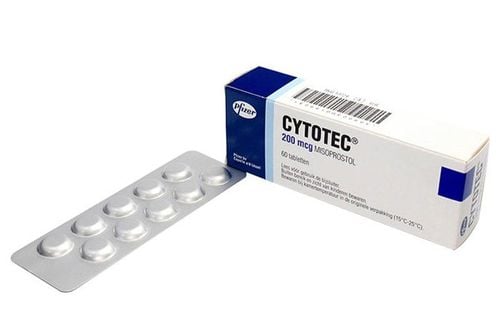This is an automatically translated article.
Pantoprazole SODIUM is indicated in the treatment of some stomach and esophageal problems such as acid reflux, preventing ulcers,... Besides, Pantoprazole medicine also reduces symptoms of heartburn, difficulty swallowing. and persistent cough.
1. Uses of Pantoprazole SODIUM
Pantoprazole SODIUM belongs to a group of drugs called proton pump inhibitors (PPIs), which are used in the treatment of certain stomach and esophageal problems such as gastroesophageal reflux disease. acid-induced injury, prevent ulcers and possibly prevent esophageal cancer. Pantoprazole works by reducing the amount of acid in the stomach, which in turn relieves symptoms such as heartburn, difficulty swallowing, and a persistent cough.2. How to use Pantoprazole SODIUM
Pantoprazole SODIUM is made in the form of tablets, so it is used orally. Swallow the tablet whole, do not split, crush or chew it, as this will release all the medicine at once and may cause unwanted reactions. For granules, it should be taken 30 minutes before meals, mixed with water and taken in sips, do not crush or chew the granules.
Dosage and duration of treatment should be based on the patient's health status and ability to respond. Use the medicine regularly, at the right time to get the most benefit. In addition, when the condition is better, continue to use the drug for the prescribed treatment period, do not arbitrarily stop or stop taking the drug.

Thuốc Pantoprazole SODIUM nên thuốc được sử dụng bằng đường uống
3. Side effects of Pantoprazole SODIUM
Some unwanted effects of Pantoprazole SODIUM include:
Headache Diarrhea Risk of fracture Unexplained weight loss Low blood magnesium level: the patient will have symptoms such as fast or slow heart rate , persistent muscle spasms, convulsions,... Signs of Lupus : rash on the nose and cheeks, joint pain,... Gastrointestinal problems: diarrhea associated with clostridium difficile , persistent diarrhea long, bloody stools,... Therefore, do not use antidiarrheal drugs or opioids. Vitamin B12 deficiency: This condition is very rare, however the risk is increased with long-term daily use (from 3 years or longer). Symptoms include unusual weakness, sore tongue, numbness or tingling in the hands or feet. Allergic reactions : difficulty breathing , rash , itching swelling especially of the face , tongue , or throat , ... Signs of kidney : change in urine output For maximum prevention of unwanted effects , patients need to inform the doctor about their allergy history as well as their existing medical history, especially liver disease, lupus, ... so that the doctor can prescribe the appropriate medication.
4. Precautions when using Pantoprazole SODIUM
Notes when using Pantoprazole SODIUM include:
Calcium and vitamin D supplements: prevent the risk of fractures and bone loss, especially for those who have used the drug for a long time with high doses. are more sensitive to the drug and have a higher risk of side effects, so be careful when using the drug in the elderly Pregnant women: should only be used when absolutely necessary during pregnancy Besides , if you miss a dose, take it immediately if you remember or skip the missed dose if it is almost time for your next dose. Never double the dose or quit.

Sử dụng thuốc Pantoprazole SODIUM cần tuân thủ đúng chỉ định của bác sĩ
5. Drug interactions
Some medicines when used with Pantoprazole SODIUM can cause drug interactions and change the way the medicine works, or increase the risk of serious unwanted effects. Drugs that interact with Pantoprazole SODIUM include:
Methotrexate Ampicillin Atazanavir Erlotinib Nelfinavir Pazopanib Rilpivirine Some azole antifungals: itraconazole, ketoconazole , posaconazole In addition, the drug may alter the results of laboratory tests such as urine tests. find tetrahydrocannabinol, blood test for certain tumors,... Therefore, patients need to save the prescription they are using so that the doctor can prescribe the right medicine.
Vinmec International General Hospital is one of the hospitals that not only ensures professional quality with a team of leading medical doctors, a system of modern equipment and technology. The hospital provides comprehensive, professional medical examination, consultation and treatment services, civilized, polite, safe and maximum sterilization space. Customers when choosing to perform tests here can be completely assured of the accuracy of test results.
Please dial HOTLINE for more information or register for an appointment HERE. Download MyVinmec app to make appointments faster and to manage your bookings easily.
6. How to store medicine
Pantoprazole SODIUM should be stored at room temperature and protected from light and moisture. Keep medicine away from children and household pets. In addition, when the medicine is expired or no longer needed, dispose of it as directed by your pharmacist or local waste disposal company, do not discharge the medicine into the water source without instructions to avoid environmental pollution. school.
Thuốc Pantoprazole SODIUM cần được bảo quản đúng cách
In summary, Pantoprazole SODIUM is a proton inhibitor drug used in the treatment of some stomach and esophageal problems such as gastroesophageal reflux disease, healing damage caused by acid. , prevent ulcers and possibly prevent esophageal cancer. In addition, the drug relieves symptoms such as heartburn, difficulty swallowing, and persistent cough. However, if the drug is used indiscriminately without a doctor's prescription, it can cause serious unwanted effects. Therefore, it is necessary to use the drug as prescribed by the doctor, when you see unusual signs such as headache, abdominal pain, sweating, digestive disorders, ... it is necessary to immediately notify the medical staff. for timely intervention.
Reference source: webmd.com













